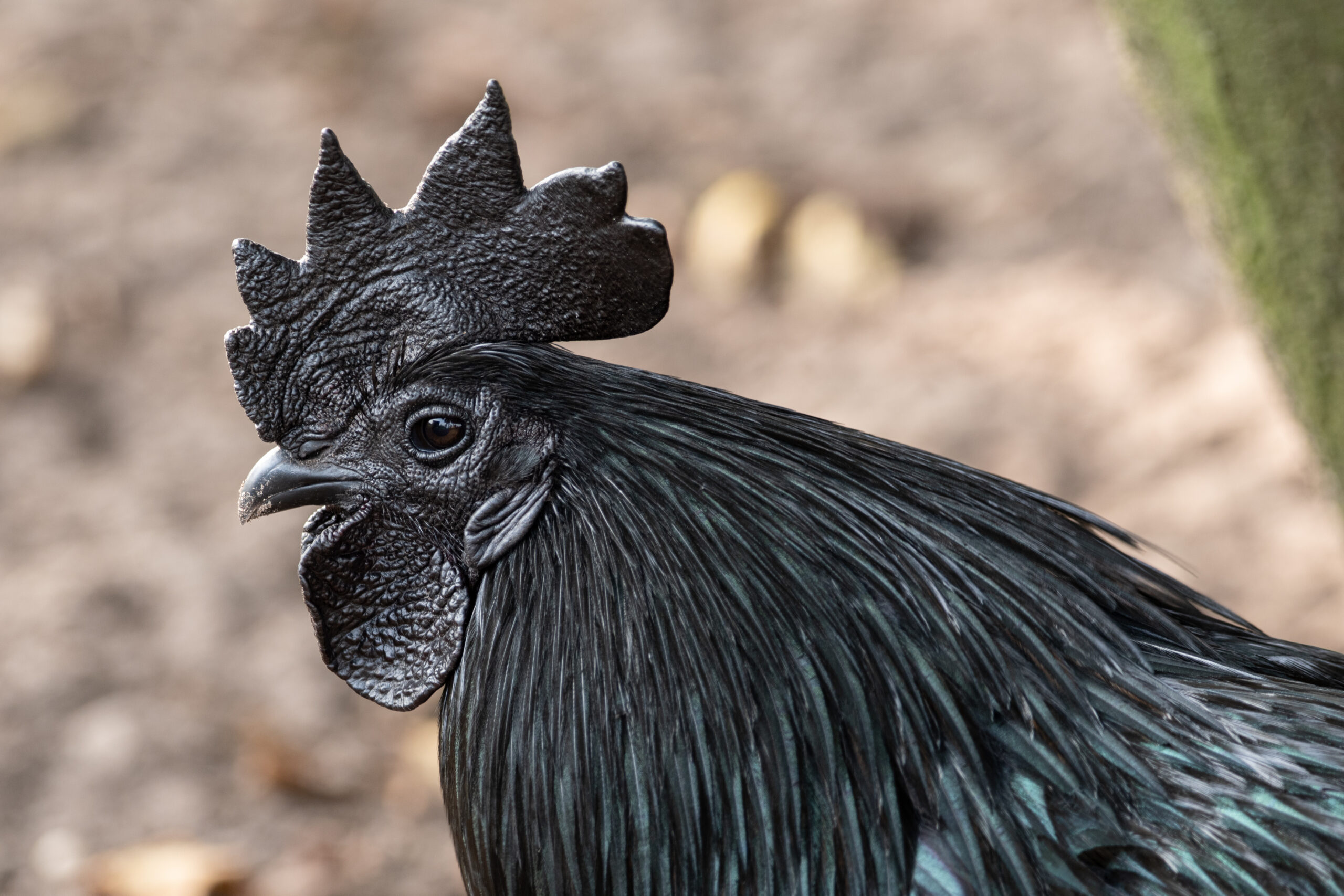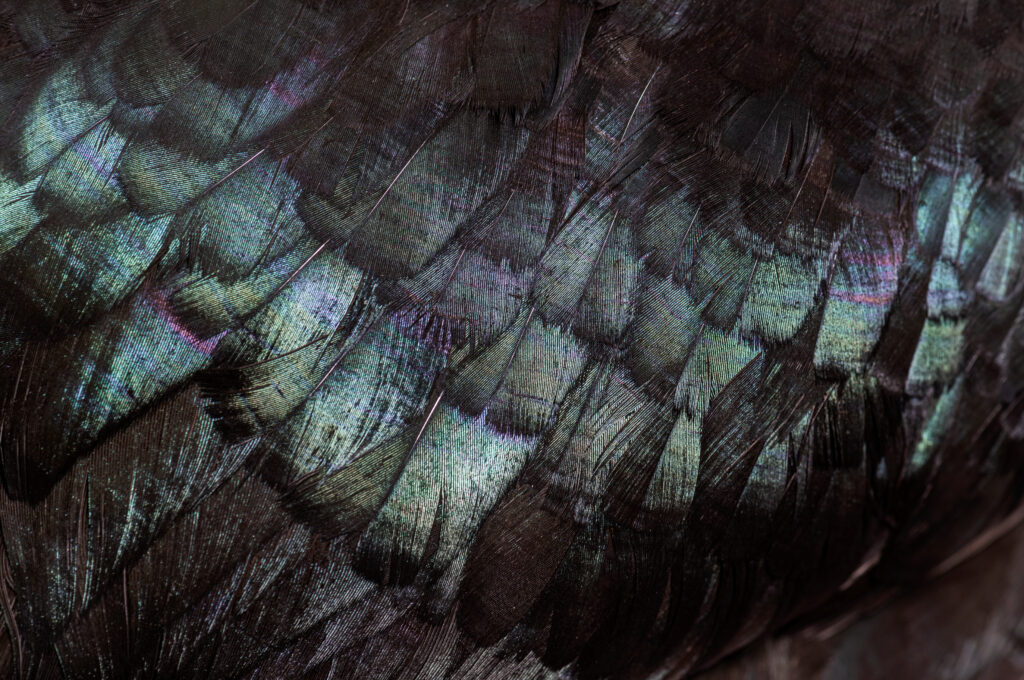
Ayam Cemani is a rare breed of chicken that originated from the island of Java in Indonesia. This unique breed is famous for its black feathers, black skin, black eyes, black comb, and even black internal organs. The word “Cemani” in the breed’s name means “completely black” in Javanese.
Ayam Cemani chickens are considered exotic due to their striking appearance, but they are also highly prized for their meat and eggs. The chickens are small to medium-sized, weighing around 4 to 6 pounds. They have a muscular build, and their black feathers are iridescent and shiny. Their skin, beak, and internal organs are also black, giving them a distinctive and dramatic appearance.
The Ayam Cemani is a hardy breed and can adapt well to different environments, making them popular among chicken enthusiasts worldwide. They are good foragers, active, and require little maintenance. Ayam Cemani chickens are also known to be docile and friendly, making them a great addition to any backyard flock.
The breed is a slow maturing bird, taking up to 18 months to fully mature. They lay medium-sized eggs that are cream-colored. Although they are not known to be prolific layers, their eggs are highly valued for their unique appearance.
Due to their rarity, Ayam Cemani chickens are relatively expensive compared to other chicken breeds. They are also difficult to breed, and breeding them requires a lot of skill and knowledge due to their genetic makeup. It is also important to note that Ayam Cemani chickens are not recognized as an official breed by the American Poultry Association.
Ayam Cemani chickens are a unique and exotic breed that is highly prized for their striking appearance, meat, and eggs. They are docile and friendly, making them a great addition to any backyard flock. However, due to their rarity and high price, they are not suitable for everyone. If you are interested in owning an Ayam Cemani chicken, it is essential to do thorough research and ensure that you have the necessary knowledge and resources to obtain true Cemani.

The coveted “Black Tongue”
Breeding for black tongue in Ayam Cemani chickens is primarily done for aesthetic purposes, as having an all-black tongue adds to the bird’s overall striking appearance. The black tongue is a natural characteristic of the breed due to a genetic mutation that causes excessive production of melanin, the pigment responsible for black coloration. However, some breeders may selectively breed for black tongue to intensify the trait or to ensure that all of their birds have the characteristic.
Breeding for black tongue is a controversial practice as it can potentially harm the breed’s overall health and genetic diversity. Focusing solely on the aesthetic trait of black tongue can lead to neglect of other important breed characteristics, such as size, shape, and temperament. Furthermore, inbreeding to intensify the black tongue trait can lead to genetic defects and health issues in the birds.
It is important to note that selective breeding for black tongue in Ayam Cemani chickens is not a recognized standard in breeding the breed. The breed is already highly valued and sought after for its unique all-black appearance, including the black beak and tongue. The natural occurrence of the black tongue in the breed should be maintained through careful breeding practices that prioritize overall health and breed characteristics.
In conclusion, while breeding for black tongue in Ayam Cemani chickens is a controversial practice, it is primarily done for aesthetic purposes. It is important to prioritize overall breed health and diversity in breeding practices to maintain the breed’s excellence and unique appearance. The natural occurrence of the black tongue in the breed should be maintained through careful breeding practices that prioritize overall breed health and genetic diversity.

The Standard of Perfection
The current draft submitted to the American Poultry Association can be found below. Please note that the Standard of Perfection has not yet been accepted, however, the Ayam Cemani Breeders Association remains steadfast in developing a Standard of Perfection for the protection and betterment of the breed.
Ayam Cemani Standard Of Perfection, Revision #6
Classification: All Other Standard Breeds AOSB
The Ayam Cemani is a breed developed from the selective breeding of a naturally occurring mutation of wild landrace chickens in Central Java. This mutation is black hyperpigmentation called fibromelanosis (fibro). While the mutation had occurred sporadically in this landrace variety for centuries, steps were taken to select towards an all-black bird in the early 20th century.
There is some variety in type and breeders have selected towards the purification of black coloring as well as for single comb in a game bird with an alert upright stance. The defining characteristic of this breed is intense black coloring that make them completely black all the way to the bone. The blackest birds are sought after in Asian countries for belief in their mystical and medicinal powers and ceremonial dishes.
Economic Qualities
These fowl are a collectors? breed as they are not known to be prolific layers, but are valued for their dark meat. Color of egg shells is white tinted to cream.
Disqualification
Any foreign color in plumage. Pink present in the mouth (showing incomplete fibro). (See General Disqualifications and cutting for defects)
Defects
Any foreign color in mouth besides black or grey. Faded plumage and unevenness of color. Toenails any color other than black.
Standard Weights
Cock. . . . . . . 5lbs
Hens. . . . . .3.5lbs
Cockerel. . . . 4lbs
Pullets. . . . .2.5lbs
Shape: Male
Comb: Single; fine in texture, of large size, straight and upright; firm and even on the head (fig. 68), having five distinct points, deeply serrated and extending well off the back of the head with no tendency to follow the shape of neck; smooth, free from twists or folds.
Beak: Medium length, strong and well curved.
Face: Clean, finely textured.
Eyes: Round, dark and prominent.
Wattles: Medium, smooth and free of wrinkles, matching in size and shape.
Ear lobes: Small, smooth in texture, oval shape.
Head: Moderate in length, strong with a moderate crown.
Neck: Moderately long, nicely arched, narrow but strong. Hackle feathers can be wiry and may reach the shoulders.
Back: Medium in length, sloping down from the neck. Wider at the shoulder and becoming narrow at the junction of the tail.
Tail: Tail carried at 45-degree angle, broad and well spread.
- Sickles: narrow, medium in length, slightly curved.
- Coverts: abundant
Wings: Medium length, carried tight, slightly lower than the horizontal plane, slightly higher at the shoulder. Strong, prominent points, well folded to the body.
Breast: Fairly broad, held high.? Round and firm but not overly muscled.
Body: Medium sized elegant form that is slim and sleek.? Muscled not bulky.
Legs and Toes: Legs set well apart, straight when viewed from front.
- Lower Thighs: Short, thick, and muscular, sloping slightly into hock.
- Shanks: Medium length.
- Toes:?Four toes, well spread with prop toe standing back and firm on the ground.
Plumage: Feathers short, rather narrow, hard, and firm, fitting closely in all sections.
Appearance: Stands proud and alert, with a game-like stance.
Shape: Female
Comb: Single; fine in texture, of medium size, straight and upright; firm and even on head, having five distinct, deeply serrated points.
Beak: Medium length, strong and well curved.
Face: Clean, finely textured.
Eyes: Round, dark and prominent.
Wattles: Medium, smooth and free of wrinkles.
Ear Lobes: Small, oval shape, smooth in texture.
Head: Moderate in length, strong and confident expression.? Crown adds mild depth to the eyes.
Neck: Moderately long, nicely arched, thin but strong.? Hackle feathers can be wiry and may reach the shoulders.
Back: Medium in length, sloping down from the neck.? Wider at the shoulder.
Tail: Good length, carried at 45 degree angle and moderately spread.
Wings: Medium length, carried tight and proud slightly lower than the horizontal plane, slightly higher at the shoulder.? Strong, prominent points, well folded to the body.
Breast: Fairly broad and held high.? Round and firm but no over muscled.
Body: Medium-sized elegant form that is slim and sleek.? Muscled, but not bulky.
Legs and Toes: Legs set well apart, straight when viewed from front.
- Lower thighs: Short, thick, and muscular, sloping slightly into hock.
- Shanks: Medium length.
- Toes:?Four toes, well spread with prop toe standing back and firm on the ground.
Plumage: Feathers short, rather narrow, hard and firm, with little fluff, fitting close to the body.
Apearance: Stands proud and alert, with a game-like stance.
Color: Male and Female
Comb, Face, Wattles, and Earlobes: Intense black fibro.
Beak: Dull black.
Eyes: Dark brown to black.
Shanks and Toes: Black, laced in grey.

great article